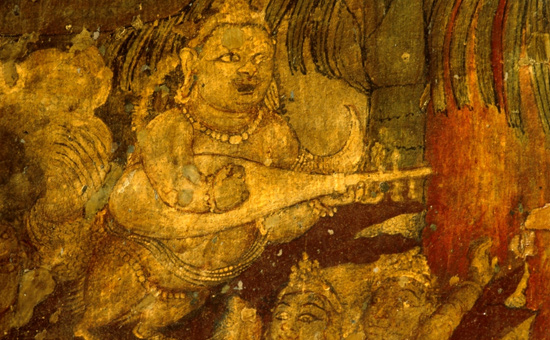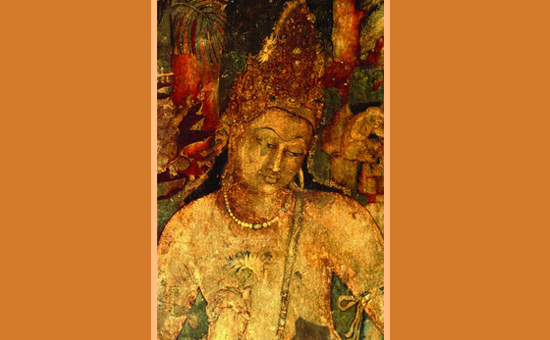- This article has a brief introduction about the caves, its paintings and photographer Benoy’s views on Ajanta.
In ancient times,
monks headed to the Ajanta Caves in Aurangabad, Maharashtra, India for their
monsoon retreats while merchants and pilgrims made stopovers to rest there. The
caves were abandoned in 5th century AD and were not discovered until some 1,400
years later. Civilisations came and went and eventually, the caves were
forgotten. Thick undergrowth flourished and camouflaged the caves.
In 1819, a colonial British officer named Captain John Smith, on a tiger-hunting party, stumbled upon the caves. With mankind’s rediscovery of the splendour of Ajanta, news spread and attempts were made to put Ajanta in the limelight again as well as unveil its treasures - fine mural paintings – to the world.
In mid-1991, Benoy
K. Behl, a New Delhi-based photographer, art historian, filmmaker and author,
visited Ajanta and was overwhelmed. He took photographs of the caves and shared
his work with the world.
“India has some of the finest ancient paintings in the world and they are an inspiration for Buddhist paintings across Asia. The Ajanta murals are the earliest surviving paintings in the Indian subcontinent.
“Found in the dark recesses of caves and interiors of temples, these murals have not been clearly photographed or seen by many,” said Behl, 63, who was in Kuala Lumpur in May for the Buddhist Heritage of The World exhibition.
The cave paintings of Ajanta are ranked among the world’s most important cultural treasures. The Ajanta Caves, a horseshoe site around the Waghora river, comprise 29 rock-cut Buddhist cave monuments dated 2nd century BC - 480AD.
They are made up
of ancient monasteries and worship halls of different Buddhist traditions
carved into a 75m (246ft) wall of rock. Within them are paintings depicting the
past lives and rebirths of the Buddha and rock-cut sculptures of Buddhist
deities.
In 1983, the
Ajanta Caves was declared a UNESCO World Heritage Site.
 Kinnara in Cave 1.
Kinnara in Cave 1.
Full Caption - A kinnara is a paradigmatic lover, a
celestial musician, half-human and half-bird in Buddhist and Hindu mythology,
who sings.
Ancient art
To help them see
in the darkness, ancient craftsmen used reflectors outside and inside the caves
to diffuse light.
Stone cutters
hacked out massive caves, carved graceful figures and fashioned beams and
rafters from the rock to mimic wooden buildings.
Painters created
stunning murals about princely processions, women with their handmaidens,
bejewelled animals and ascetics in monasteries, said Behl, author of The Ajanta
Caves (1998).
His other books
include Northern Frontiers of Buddhism (2013), The Art Of India (2017),
Buddhist Heritage Of Sri Lanka, Buddhism: The Path Of Compassion (2018) and
Hindu Deities Worshipped In Japan (2019).
Behl went to the
Ajanta Caves every day for two months, taking over 1,000 photographs of the
ancient Buddhist cave paintings, which date from 2nd century BC to 5th century
AD.
He used long
exposures that pick up natural ambient light to capture the artworks in all its
glory.
“I photographed the paintings in all the caves at Ajanta. The ones with the most paintings are Caves 1, 2, 9, 10, 16 and 17,” he recalled.
The paintings, he
noted, are all over the caves, except on the floor. At various places, the
artworks have been eroded due to decay and human interference. Many areas of
the painted walls, ceilings and pillars are fragmented.
“The walls are alive with men, women and children, rich and poor, in towns and villages, engaged in all the activities of life. The humble ants were also not forgotten and were depicted climbing a tree in Cave 17.”
Behl finds the Bodhisattva Padmapani mural in Cave 1
of Ajanta to be one of the most graceful paintings.
“Padmapani means ‘Bearer of the Lotus’ and he brings before us the ‘Peace of the Spirit’. Around him, there were playful monkeys, birds and a kinnara (a paradigmatic lover and celestial musician who is half-human and half-bird in Buddhist and Hindu mythology) who sings. Despite all these distractions, he looks within,” he said.
These paintings, Behl added, “take us far from the attachments and confusion of the world around us, to a peaceful realm which can be found within. In fact, an inward look is found on the faces of the Bodhisattvas of Ajanta.”
 A wall painting of Bodhisattva Padmapani in Cave 1.
A wall painting of Bodhisattva Padmapani in Cave 1.
Behl said this is one of the most graceful paintings in Ajanta. "Padmapani means Bearer of the Lotus and he brings before us the Peace of the Spirit," he said.
There were
thousands of painted figures all over the walls of the caves, he noted. Each
one exudes the spirit of compassion. Most of the paintings were inspired by the
Jataka tales about the life of Buddha.
“I would be caught up in the caves with my work once inside. I would only emerge outside for 10 minutes or so, for lunch or toilet breaks. Spending so much time in the presence of so many gracious figures filled me with a new sense of joy and optimism,” he recalled.
The experience
impacted him so much that he subsequently made films on art and philosophy.
Thus far, he has produced 140 documentaries on Indian art and cultural history.
Ground-breaking technique
Behl’s photographs were acknowledged by experts all over the world as the best depiction of the details and colours of the Ajanta paintings. He is famed for his groundbreaking, low-light photography technique which he perfected over 10 years before going to the Ajanta Caves.
“Everybody said I captured the true details and colours of the Ajanta cave paintings for the first time,” he said, adding that he has been invited by universities and museums abroad to talk about his work.
Despite the flood
of congratulatory messages, Behl felt he could have done better.
“I felt that (the early photos of Ajanta) were not good enough and I returned to the caves (a year later) to reshoot the paintings. It’s not for people to decide whether my work is good enough or not.
“Ultimately, the judge has to be yourself and your own desire for perfection,” he said.
Behl feels that
the colours of the photographs are more perfect the second time round, although
the brightness remains the same. It is these photographs which he showcases to
the world at exhibitions. In his discovery of art heritage, Behl has travelled
around the world 10 times, making him the most travelled photographer in India.
“I like all the historical places I have been to – every one of them,” he mused. “Looking back, I’ve led a very fortunate life and continue to enjoy a life filled with travels. When you explore more, you also learn more about yourself.”
Behl is reputedly the only person in the world to document Buddhist heritage in 19 regions across 17 countries. Asked about his religion, he said,” I’m not a follower of any religion but respect all faiths due to works on Hinduism, Buddhism and Jainism.”
One thing’s for sure; the Ajanta murals will remain a significant part of his memories for a long time.
“There is gentleness, kindness, generosity, love and warmth in the painted figures. The faces and gestures can only come from the beauty and gentleness within. I was spirited away to a world of compassion.”
Article was first published here. eSamskriti.com has obtained permission from Benoy K. Behl to share this article.
To see pictures by Sanjeev
1. Ajanta Caves
1 and 2
2. Ajanta
Caves 4,6,7,9,10,11,19
3. Ajanta
Caves 16, 17
4. Ajanta
Caves 20,21,24,26
5. Kailasa
Temple Ellora
6. Buddhist
Caves Ellora